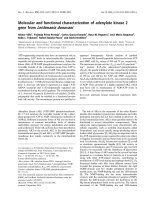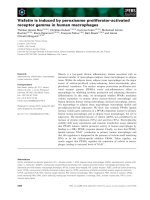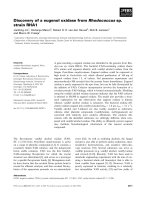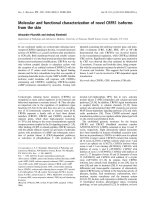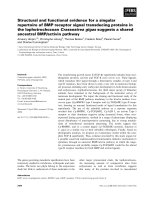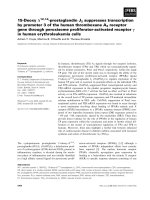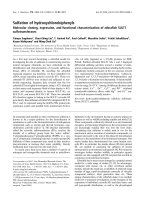Discovery of botanical flavonoids as dual peroxisome proliforator, activated receptor (PPAR) ligands and functional characterization of a natural PPAR polymorphism that enhances interaction with nuclear compressor
Bạn đang xem bản rút gọn của tài liệu. Xem và tải ngay bản đầy đủ của tài liệu tại đây (2 MB, 263 trang )
DISCOVERY OF BOTANICAL FLAVONOIDS AS DUAL
PEROXISOME PROLIFERATOR ACTIVATED
RECEPTOR (PPAR) LIGANDS
AND
FUNCTIONAL CHARACTERIZATION OF A NATURAL
PPARα POLYMORPHISM THAT ENHANCES
INTERACTION WITH NUCLEAR COREPRESSOR
LIU MEI HUI
(B. Appl. Sci. (Hons.), NUS)
A THESIS SUBMITTED FOR THE DEGREE OF
DOCTOR OF PHILOSPHY
NATIONAL UNIVERSITY OF SINGAPORE
2007
i
ACKNOWLEDGEMENTS
I would like to express the deepest gratitude to my supervisor, Professor EL Yong, for his
patience and guidance. Besides training me as a scientist, he has taught me the values of
hard work and perseverance. To me, these will be the most valuable lessons I leave the
lab with. I am grateful for he has prepared me to meet the challenges that come in life
which no other teacher has achieved. Thank you, Prof!
I would like to thank Dr Shen Ping and Dr Loy Chong Jin for preparing me in my
initiation ‘teething’ years transitioning from the field of Chemistry to the field of
Molecular Biology. I would also like to thank Dr Tai E Shyong, for being my advisor and
friend; and for giving me my last lifeline. Many, many thanks to Dr Li Jun for his pivotal
role in my research training. I am nothing I am today without Dr Li Jun’s constant,
unwavering guidance and patience. I hope I did not cause too much anguish to all my
teachers but thanks, once more. I would like to thank all lab members past and present for
making the stay in the lab a truly enjoyable experience. To the following people who had
paused in their lives to offer me words of encouragement: Dr Li Jun, Dr Shen Ping, Dr
Tai E Shyong, Dr Shen Han-ming, Dr Martin Lee, Dr Tang Bor Luen, Wilson, Elissa,
Sook Peng, Toon Ya and so many others who I fail to mention here. I appreciate your
kind words at crucial times. Thanks for not giving up on me even when I have lost faith
in myself sometimes.
I would also like to thank my friends, especially the close knitted AGS class (we
will make it!), for the constant support. Thanks to the staff of NGS for their
understanding and care for us students.
ii
Finally, I would like to thank my family, Mum, Dad, Aunt and Sis for putting up
with my constant absence at home. For their love, patience, understanding and
encouragement. For every little thing they did to keep me going. Thanks for the four leaf
clover, I think it works! Most importantly, I would like to thank my better half, for being
my pillar of strength and center of rationality. For his love, sacrifices and faith. It has
been hard with the long distance between us and I miss not having you around.
To Jit Kong, ditto.
iii
TABLE OF CONTENTS
ACKNOWLEDGEMENTS i
TABLE OF CONTENTS iii
SUMMARY vi
LIST OF TABLES ix
LIST OF FIGURES x
LIST OF PUBLICATION xiv
ABBREVIATIONS xv
CHAPTER 1 INTRODUCTION 1
1.1 The Peroxisome Proliferator Activated Receptor 3
1.2 Physiological Aspects of PPAR 11
1.3 Ligands of PPAR 21
1.4 Molecular mechanisms of PPAR activity 27
1.5 Molecular mechanisms of PPAR activity- Coregulators 34
1.6 Natural polymorphisms of the PPARα gene 48
1.7 Flavonoids 53
1.8 Objectives 62
CHAPTER 2 MATERIALS AND METHODS 65
2.1 DNA manipulation 67
2.2 Materials and reagents 70
2.3 Cell culture 71
iv
2.4 Transient transfection and reporter gene assay 71
2.5 Ligand binding assay 72
2.6 Adipocyte differentiation assay 73
2.7 Western analysis 73
2.8 Reverse transcription polymerase chain reaction (RT-PCR) 74
2.9 Immunoflourescence 75
2.10 siRNA knockdown 75
2.11 Glutathione-S-transferase (GST) pull down 76
2.12 Immunoprecipitation (IP) 77
2.13 Chromatin immunoprecipitation (ChIP) 77
2.14 Isolation and structural characterization of bioactive compounds 78
2.15 Statistical analysis 79
CHAPTER 3 RESULTS 80
3.1 Discovery of PPAR bioactive flavonoids from the anti-diabetic herb,
Pueraria Thomsonii 83
3.2 Characterization of flavonoids on PPARα and PPARγ activity 103
3.3 Characterization of flavonoids and PPARα ligands on a natural PPARα
V227A variant 124
3.4 Mechanism(s) elucidation of attenuated PPARα V227A activity 140
3.5 Molecular mechanism of attenuated PPARα V227A activity by NCoR 150
3.6 Summary of results 170
v
CHAPTER 4 DISCUSSION
4.1 Botanicals as a rich source of PPAR active ligands 174
4.2 Isoflavones in anti-diabetic botanicals are PPARα/PPARγ dual agonists 177
4.3 Flavonoid structure and PPAR activity 181
4.4 Potential application of diosmetin as a selective PPARγ ligand 184
4.5 Potential application of flavonoids and their parent botanicals as PPAR
activators 185
4.6 Gene-environment interactions 187
4.7 Mechanism(s) for attenuated PPARα V227A activity 191
4.8 Coactivators and PPARα interaction 193
4.9 Corepressors and PPARα interaction 197
4.10 NCoR ID and PPARα interaction 200
4.11 Function of PPARα hinge in corepressor interaction 203
4.12 Molecular mechanism of attenuated PPARα V227A transcription 206
4.13 Conclusion 211
BIBLIOGRAPHY 212
APPENDIX 244
vi
SUMMARY
Peroxisome Proliferator Activated Receptors (PPAR), part of the 48 member
nuclear/steroid receptor superfamily of transcription factors, have critical roles in lipid
and carbohydrate metabolism. While PPARγ regulates glucose levels and adipogenesis,
PPARα is highly expressed in tissues involved in fatty acid metabolism where it regulates
several key proteins in fatty acid oxidation and ketogenesis. Compounds that target
PPARα and PPARγ are used extensively in the clinical setting to correct dyslipidemia
and to restore glycemic balance in diabetes and atherosclerosis. However many of the
drugs in current use have significant adverse effects. Therefore, there is a need for the
discovery of more PPAR-active compounds with beneficial efficacy/risk profiles.
Recently, natural variants of PPAR have been shown to be functionally significant
and are important determinants of cardiovascular and metabolic health. In particular, a
non-synonymous variant at the PPARA locus encoding a substitution of valine for alanine
at residue 227 (V227A) in the hinge region of the PPARα has been observed in Singapore
and other East-Asian populations with relatively high allelic frequencies. This variant
was associated with perturbations in plasma lipid levels and modulated the association
between dietary polyunsaturated fatty acids and high density lipoprotein cholesterol. The
impact of this variant on the function of PPARα is unknown.
To address the above issues, the objectives of this study were:
1) To identify, isolate and structurally characterize PPAR active
compounds from an anti-diabetic botanical, Pueraria Thomsonii (PT),
and to characterize their functional effects in relevant cell models.
vii
2) To examine the effects of the V227A variant on PPARα function and to
elucidate the molecular mechanisms for any observed effects.
Firstly, we demonstrated that extracts of PT can activate PPARα and PPARγ.
Repeated bioassay guided fractionation resulted in the identification and isolation of the
isoflavones, daidzin, daidzein, genistin, puerarin and 2’hydroxydaidzein, as bioactive
compounds of PT. We characterized the effects of daidzein from PT and other
isoflavones, calycosin, formononetin, genistein and biochanin A, using chimeric and full-
length PPAR constructs in vitro. Biochanin A and formononetin were potent activators of
both PPAR receptors (EC50=1-4 μM)
with PPARα/PPARγ activity ratios of 1:3 in the
chimeric and almost 1:1 in the full length assay, comparable to that observed for
synthetic dual PPAR-activating compounds under pharmaceutical development. There
was a subtle hierarchy of PPARα/γ activities with biochanin A, formononetin and
genistein being more potent than calycosin and daidzein in chimeric as well as full length
receptor assays. At low doses only biochanin A and formononetin, but not genistein,
calycosin or daidzein, activated PPARγ-driven reporter gene activity and induced
differentiation of 3T3-L1 preadipocytes. Our data suggest the potential value of
isoflavones, especially biochanin A, and their parent botanicals as anti-diabetic agents
and for use in regulating lipid metabolism.
Secondly, the functional significance of the V227A substitution was explored.
The polymorphism significantly attenuated PPARα mediated transactivation of the
CYP4A6 and mitochondrial 3-hydroxy-3-methylglutaryl-CoA synthase (HMGCS2)
genes, with polyunsaturated fatty acids and the fibrate, WY14,643, in a dominant-
negative manner. Screening of a panel of PPARα coregulators revealed that V227A
viii
enhanced recruitment of the nuclear corepressor, NCoR. Weaker transactivation activity
of V227A can be restored by silencing NCoR, or by inhibition of its histone deacetylase
activity. Deletion studies indicate that PPARα interacts with NCoR receptor-interacting
domain 1 (ID1), but not ID2 or ID3. These interactions were dependent on the intact
consensus nonapeptide nuclear receptor interaction motif in NCoR ID1, and were
enhanced by the adjacent 24 N-terminal residues. Novel corepressor interaction
determinants involving PPARα helices 1 and 2 were identified. The V227A substitution
stabilized PPARα/NCoR interactions in the unliganded state, and caused defective
corepressor/coactivator exchange in the presence of ligands, on the HMGCS2 promoter
in hepatic cells. These results provide the first indication that defective function of a
natural PPARα variant was due to increased corepressor binding.
In all, our data suggest that the PPARα/NCoR interaction is physiologically
relevant, and can produce a discernable phenotype when the magnitude of the interaction
is altered by a naturally occurring variation. Our detailed mechanistic study of the
PPARα V227A variant allows for the design of future human studies to identify other
benefits and risks associated with this mutation. Furthermore, the identification and
characterization of isoflavones, and their parent botanicals, with different PPARα/γ
potencies suggest their value in the management of the epidemic of diabetes,
dyslipidemia and the metabolic syndrome.
ix
LIST OF TABLES
Table 1.1
DNA binding properties of homodimers and RXR
heterodimers of nuclear receptors
4
Table 1.2
Association studies of the V227A polymorphism
51
Table 3.1
Compounds isolated from various fractions of MPLC
separation of PT ethyl acetate extract
102
Table 3.2
Comparative PPAR activity of commonly consumed
isoflavones
107
Table 3.3
Interaction of coregulators with PPARα in the Mammalian-
Two-Hybrid Assay
147
Table 4.1
Common botanicals/foods rich in selected isoflavones
178
Table 4.2
Comparisons of activity ratios between natural and synthetic
dual PPARα/PPARγ dual agonists
180
Table 4.3
Summary of coregulator interaction of PPARα
195
Table 4.4
Summary of corepressor interaction with PPAR
199
Table 4.5
Summary of NCoR interaction domain (ID) binding preferences
to selected nuclear receptors
202
x
LIST OF FIGURES
Figure 1.1
Schematic illustration of the general structural and functional
organization of a nuclear receptor (NR)
6
Figure 1.2
General structure of human PPAR
8
Figure 1.3
PPARα in lipid metabolism
12
Figure 1.4
Selected PPAR ligands
23
Figure 1.5
A simplified schematic of the nuclear corepressor, NCoR
36
Figure 1.6
Illustration of antagonist bound PPAR with corepressor and
its comparison with agonist bound PPAR/coactivator
39
Figure 1.7
Models of PPAR action
47
Figure 1.8
Basic structure of flavonoid and structures of selected
flavonoids
54
Figure 3.1.1A
Schematic representation of PPAR reporter gene bioassays
84
Figure
3.1.1B,C
Dose response curves of chimera Gal-PPAR reporter gene
bioassays
87
Figure 3.1.2
Effects of Pueraria thomsonii (PT) extract on chimera Gal-
PPAR reporter gene bioassays
88
Figure 3.1.3
Schematic representation of strategy for bioactive
compounds identification through bioassay guided
fractionation
90
Figure 3.1.4
PPAR activity of solvent extracted fractions of PT
92
Figure 3.1.5
Dose response of ethyl acetate PT layer on chimera Gal-
PPAR reporter gene bioassays
94
Figure 3.1.6
MPLC separation of PT ethyl acetate extract using silica as
the solid phase matrix
96-98
Figure 3.1.7
PPAR activity of fractions from HPLC separation of
PPARα active Fraction 32 with a Diol column
101
xi
Figure 3.2.1
Effect of isoflavones on chimera Gal-PPAR reporter gene
bioassays
106
Figure 3.2.2
Dose response curves of full length PPAR reporter gene
bioassays
108
Figure 3.2.3
Effects of isoflavones on full length PPAR activity
109
Figure 3.2.4
Effects of isoflavones on selected PPARα regulated genes
in HepG2
112
Figure 3.2.5
PPARγ competitive ligand binding assay
113
Figure 3.2.6
Effects of isoflavones on endogenous PPARγ function in
adipocytes
115
Figure 3.2.7
Effects of isoflavones on 3T3-L1 preadipocyte
differentiation
117
Figure 3.2.8
Screening of different groups of flavonoids for PPAR
activity
119
Figure 3.2.9
Identification of the non-isoflavonoid, Diosmetin, as a
PPARγ selective agonist
121
Figure 3.2.10
Effects of flavonoids on selected PPAR regulated genes in
differentiated 3T3-L1 cells.
123
Figure 3.3.1A
Amino acid sequence comparison of Helices 1 and Helix 2 of
T3Rβ and PPARα
126
Figure 3.3.1B
The PPARα V227A variant exhibits similar transactivation
activity on the consensus CYP4A6-PPRE with genistein and
biochanin A
127
Figure 3.3.2
The PPARα V227A variant exhibits lower transactivation
activity on the CYP4A6-PPRE in the presence of
WY14,643 and α-linolenic acid
129
Figure 3.3.3
The PPARα V227A variant exhibits similar transactivation
activity on the CYP4A6-PPRE with linoleic acid and
fenofibrate
132
Figure 3.3.4
The PPARα V227A variant exhibits lower transactivation
activity on the CYP4A6-PPRE with GW9662
133
xii
Figure 3.3.5
Lower PPARα V227A variant transactivation activity on
the consensus CYP4A6-PPRE in the presence of
WY14,643 is independent of PPARα amount
134
Figure 3.3.6
The PPARα V227A variant exhibits lower transactivation
activity on the mitochondria HMG-CoA synthase
(HMGCS2) promoter activity
137
Figure 3.3.7
The PPARα V227A variant exhibits dominant negative
activity
139
Figure 3.4.1
Effects of V227A on the ligand binding domain
142
Figure 3.4.2
Weaker transactivation of V227A is independent of RXR
content
143
Figure 3.4.3
Weaker transactivation of V227A is independent of protein
expression and nuclear localization
145
Figure 3.4.4
Interaction of NCoR in the mammalian-two-hybrid assay
149
Figure 3.5.1
Transcriptional activity of PPARαV227A is sensitive to
NCoR overexpression
151
Figure 3.5.2
NCoR silencing decreases the transcriptional difference
between PPARα WT and V227A
155
Figure 3.5.3
Transcriptional activity of PPARαV227A is sensitive to
HDAC inhibitor
156
Figure 3.5.4
Interactions between PPARα with receptor interaction
domains of NCoR
157
Figure 3.5.5
Interactions of PPARα and NCoR using GST pull down
assay
159
Figure 3.5.6
Interactions of NCoR with deletion fragments of PPARα
hinge
161
Figure 3.5.7
Ternary interactions between SRC-1, NCoR and PPARα
163
Figure 3.5.8
Effect of V227A on PPARα interaction with NCoR
166
xiii
Figure 3.5.9
Effects of V227A in the recruitment of coregulators to the
HMGCS2 promoter
167
Figure 3.5.10
Correlation of PPARα-regulated gene expression with
recruitment of NCoR to PPRE in the HMGCS2 promoter
169
Figure 4.1
Flavonoid structure and PPAR activity
183
Figure 4.2
Sequence alignment of the NCoR box of TR against PPAR
and other nuclear receptors
204
Figure 4.3
Proposed molecular mechanism of V227A using the
genome scanning model
209-
210
xiv
LIST OF PUBLICATIONS
Liu MH, Li J, Shen P, Tai ES, Yong EL. A natural polymorphism in Peroxisome
Proliferator-activated Receptor-α hinge region attenuates transcription due to defective
release of nuclear receptor corepressor from chromatin. Molecular Endocrinology.
2008;
22(5):1078-92
Yong EL, Li J, Liu MH. Single gene contributions: genetic variants of peroxisome
proliferator-activated receptor (isoform alpha, beta/delta and gamma) and mechanism of
dyslipidemias. Current Opinion in Lipidology
. 2008; 19(2):106-12
Ng TY, Liu MH, Gong Y, Loy CJ, Shen P, Yong EL. Recruitment of nonpeptide
isoflavones to the transcription complex coactivates androgen and nuclear-receptor
signaling. In preparation.
Shen P, Liu MH, Ng TY, Chan YH, Yong EL. Differential effects of isoflavones, from
Astragalus membranaceus and Pueraria thomsonii, on the activation of PPARα, PPARγ,
and adipocyte differentiation in vitro. Journal of Nutrition. 2006; 136(4):899-905
Loy CJ, Evelyn S, Lim FK, Liu MH, Yong EL. Growth dynamics of human leiomyoma
cells and inhibitory effects of the peroxisome proliferator-activated receptor-γ ligand,
pioglitazone. Molecular Human Reproduction (UK). 2005; 11:561-566
Liu MH, Shen P, Ng TY, Yong EL. Differential effects of isoflavones on the dual
activation of peroxisome proliferators-activated receptors α/γ, their related fat and sugar
metabolic genes and adipocyte differentiation. Keystone Symposium on Nuclear
Receptors: Orphan Brothers. March 18-23, 2006 at Fairmont Banff Springs, Alberta,
Canada
Liu MH, Loy CJ, Gong YH, Yong EL. The common soy bean flavonoid, genistein
interacts directly with and modulates androgen receptor coregulator activity. “Herbal
Medicines: Ancient Cures, Modern Science”, Inaugural International Congress On
Complementary And Alternative Medicines. February 26-28, 2005 at Raffles City
Convention Centre, Singapore.
Liu MH, Ng TY, Loy CJ, Gong YH, Yong EL. Detection of genistein in the androgrn
receptor complex. Medicine in the 21
st
Century- Tri-Conference & Bio-Forum. July 24-
27, 2004 at Shanghai International Convention Center, Shanghai, China.
xv
ABBREVIATIONS
15dPGJ2 15-deoxy-Δ
12,14
-Prostaglandin J2
Å
3
cubic angstrom
ABCA1 adenosine triphosphate-binding cassette transporter A1
ACO acyl-CoA oxidase
Acrp30 adipocyte complement-related protein of 30 kDa
AD activation domain
AF-1 activation function-1, ligand independent
AF-2 activation function-2, ligand dependent
AM Astragalus membranaceus
aP2 adipocyte fatty acid binding protein
apoA-I Apolipoprotein A-I
apoA-II Apolipoprotein A-II
apoA-V apolipoprotein A-V
apoC-III apolipoprotein C-III
AR androgen receptor
bp base pair
Bio biochanin A
Cal calycosin
CAP350 centrosome-associated protein 350
CARM-1 coactivator-associated arginine methyltransferase 1
CBP CREB-binding protein
cDNA complementary DNA
CD36 fatty acid translocase
C/EBP CCAAT/enhancer binding protein
ChIP chromatin immunoprecipitation
CITED-2 CBP/p300 interacting transactivator with ED-rich tail 2
CPT1A carnitine palmitoyl transferase
1A
Co-IP co-immunoprecipitation
COOH carboxyl group
CoRNR core consensus nonapeptide motif (LXXI/HIXXXI/L)
COUP-TFII COUP transcription factor II
CVD cardiovascular heart disease
CYP4A cytochrome P450 4A
Dai daidzein
DBD DNA-binding domain
DHT dihydrotestosterone
DM diabetes mellitus
DMEM Dulbecco’s modified Eagle’s medium
DNA deoxyribonucleic acid
DR direct repeat eg. DR1 is direct repeat 1
DRIP vitamin D3 receptor interacting protein
EC50 50% effective concentration
EMSA electrophoretic mobility shift assay
ER estrogen receptor
xvi
FA fatty acid
FATP-1 fatty acid transport
protein
FDA U.S. Food and Drug Administration
FAO fatty acid oxidation
For formononetin
Gen genistein
GPS2 G protein pathway suppressor 2
GR glucocorticoid receptor
GST glutathione-S-transferase
GyK glycerol kinase
h hour
H helix
HAT histone acetyltransferase
HDAC histone deacetylase
HDL high density lipoprotein
HDL-c high density lipoprotein-cholesterol
HETE hydroxyeicosatetraenoic acid
HMGCS1 cytosol HMG-CoA synthase
HMGCS2 mitochondria HMG-CoA synthase
HMT histone methyltransferase
HNF4 hepatocyte nuclear factor 4
HODE hydroxyoctadecadienoic acid
HPLC high performance liquid chromatography
HRE hormone response element
hsp90 heat shock protein 90
IC50 50% inhibitory concentration
ID interaction domain
IF immunoflourescence
IP immunoprecipitation
IR inverted repeat
kDa kilodalton
LBD ligand-binding domain
LC-MS liquid chromatography-mass spectrometry
LCoR ligand-dependent corepressor
LDL low density lipoprotein
LDL-c low density lipoprotein cholesterol
L-FABP liver fatty acid binding protein
LPL lipoprotein lipase
Luc luciferase
MAPK mitogen-activated protein kinase
Med mediator
mg milligram
min minute
mM millimolar
ml millilitre
μg microgram
xvii
μM micromolar
μl microlitre
MODY maturity-onset diabetes of the young
mP polarization value
MPLC medium pressure liquid chromatography
MR mineralocorticoid receptor
mRNA messenger ribonucleic acid
MS mass spectrometry
NCoR nuclear receptor corepressor
ng nanogram
nM nanomolar
NMR nuclear magnetic resonance
NR nuclear receptor
NS not studied
NSA no significant activity
OLR1 oxidized LDL receptor 1
PBP PPARγ binding protein
PCR polymerase chain reaction
PDK1 pyruvate dehydrogenase kinase isoform 1
PDK4 pyruvate dehydrogenase kinase isoform 4
PEPCK phosphoenol pyruvate carboxykinase
PG prostaglandins
PGC-1α PPARγ coactivator-1α
PIMT PRIP-interacting protein with methyltransferase domain
PKA protein kinase A
PKC protein kinase C
PLTP phospholipid transfer protein
Pol II RNA polymerase II
Pos positive control
PPARA locus encoding for PPARα
PPAR peroxisome proliferator-activated receptor
PPRE PPAR response element
PR progesterone receptor
PRIC PPARα interacting complex
PRIC285 PPARα interacting cofactor complex 285
PRIP PPARγ interacting protein
PRMT-1 protein arginine methyltransferase 1
PRMT-2 protein arginine methyltransferase 2
PT Pueraria thomsonii
PUFA polyunsaturated fatty acid
RAR retinoid acid receptor
RCT reverse cholesterol transport
RD repression domain
RIP140 receptor interacting protein 140
RNA ribonucleic acid
ROR retinoid- related orphan receptor
xviii
rpL11 ribosomal protein regulator of p53
rRNA ribosomal ribonucleic acid
RT-PCR reverse transcriptase-polymerase chain reaction
RXR retinoid X receptor
SEM standard error of mean
sh short hairpin
siNCoR short hairpin sequences complementary to NCoR
siScram short hairpin sequences complementary to a randomized sequence
SMRT silencing mediator of retinoid and thyroid receptors
SNP single nucleotide polymorphism
SPPARM selective PPAR modulating
SR-BI scavenger receptor BI
SRC-1 steroid receptor coactivator-1
SUMO small ubiquitin-like modifiers
SWI/SNF switch/sucrose non-fermenting complex
T3 triiodothyronine
TAD transactivation domain
TBL-1 transducin-like protein 1
TCM Traditional Chinese Medicine
TG triglyceride
TIF2 transcriptional intermediate factor 2
TK thymidine kinase
TNFα tumour necrosis factor α
TR thyroid receptor
T3Rβ thyroid receptor β
TRAP thyroid hormone receptor associated proteins
TRB3 mammalian homolog of Drosophila tribbles
TSA trichostatin A
TZD thiazolidinedione
UASG upstream activating sequence of Gal4
VDR vitamin D receptor
VLDL very-low-density-lipoprotein
WHO World Health Organization
WT wild type
XAP2 hsp90 accessory protein
1
CHAPTER 1: INTRODUCTION
1.1 The Peroxisome Proliferator Activated Receptor 3
1.1.1 The Nuclear Receptor Superfamily 3
1.1.2 The Peroxisome Proliferator Activated Receptor 7
1.2 Physiological Aspects of PPAR 11
1.2.1 PPARα 11
1.2.1.1 Lipid metabolism 11
1.2.1.2 Lipoprotein metabolism 14
1.2.1.3 Glucose metabolism 16
1.2.3.4 PPARα null mice 17
1.2.2 PPARγ 18
1.2.2.1 Insulin sensitization 19
1.2.2.2 PPARγ null mice 20
1.3 Ligands of PPAR 21
1.3.1 PPARα ligands 22
1.3.2 PPARγ ligands 24
1.3.2 Dual PPARα/PPARγ ligands 25
1.4 Molecular mechanisms of PPAR activity 27
1.4.1 Action of AF-1 and AF-2 27
1.4.2 RXR dimerization 29
2
1.4.3 Protein regulation 31
1.4.4 Post-translational modification 31
1.5 Molecular mechanisms of PPAR activity- Coregulators 34
1.5.1 Corepressor 35
1.5.2 Coactivators 40
1.5.3 Dynamics of coregulator exchange on chromatin 44
1.6 Natural polymorphisms of the PPARα gene 48
1.6.1 L162V 48
1.6.2 V227A 50
1.7 Flavonoids 53
1.7.1 Structure 53
1.7.2 Source 55
1.7.3 Isoflavones 56
1.7.3.1 Consumption, absorption and metabolism 56
1.7.3.2 Effects on lipid and glucose metabolism 57
1.7.3.3 Molecular mechanism of isoflavones 58
1.7.4 Traditional Chinese medicine, a source of flavonoids 59
1.7.4.1 The anti-diabetic herb, Pueraria Thomsonii 60
1.8 Objectives 62
3
1.1 The Peroxisome Proliferator Activated Receptor
1.1.1 The Nuclear Receptor Superfamily
Nuclear receptors (NR) are members of a large superfamily of evolutionarily related
DNA-binding transcription factors which have diverse, crucial roles in the regulation of
growth, development and homeostasis (Chambon 2005; Evans 2005; Germain et al.
2006). Since the isolation of cDNA encoding the Glucocorticoid Receptor (GR)
(Hollenberg et al. 1985) and the Estrogen Receptor α (ERα) (Green et al. 1986; Greene et
al. 1986), the sequencing of the human genome has so far led to the identification of 48
nuclear receptors (Perissi and Rosenfeld 2005).
Members of this superfamily can be broadly divided into subgroups on the basis
of their pattern of dimerization (Germain et al. 2006) (Table 1.1). One group consists of
the steroid receptors, including the Androgen Receptor (AR), the Mineralocorticoid
Receptor (MR), the GR, the ERα and ERβ (Table 1.1). These steroid receptors function
as homodimers and bind to a degenerate set of hexameric half-sites separated by 3 base
pairs of spacer (IR3) on the DNA (Glass 1994). These specific DNA sequences are called
hormone response elements (HRE) (Kumar et al. 1986). Except ER, the steroid receptors
recognize the consensus DNA half-site sequence 5’-AGAACA-3’. ER binds in similar
symmetric sites but with the consensus half-site sequence of 5’-AGGTCA-3’.
Nearly all non-steroidal receptors recognize one or two copies of the consensus
DNA half-site sequence 5’-AGGTCA-3’ that can be configured into a variety of
structured motifs (Mangelsdorf and Evans 1995; Germain et al. 2006). Among these
receptors, a major group consists of receptors that form heterodimers with the Retinoid X
4
Receptor (RXR) (Table 1.1). The various RXR heterodimers can bind to direct repeats
(DRs) with one to five base pairs of spacing, referred to as DR1 to DR5. The Peroxisome
Proliferator Activated Receptor (PPAR), the Retinoid Acid Receptor (RAR), the Vitamin
D Receptor (VDR) and the Thyroid Receptor (TR) heterodimerize with RXR on DR1 to
DR4 respectively. RAR can also heterodimerize with RXR on DR5 (Mangelsdorf and
Evans 1995). In addition, some NRs such as Rev-erb and Retinoid- related Orphan
Receptor (ROR) binds DNA efficiently as monomers (Giguere et al. 1995; Harding and
Lazar 1995).
Table 1.1 DNA binding properties of homodimers and RXR heterodimers of nuclear
receptors
Dimerization Receptor Response element Consensus sequence
AR
PR
GR
MR
IR-3 AGAACA-NNN-TGTTCT
Homodimer
ER
IR-3
AGGTCA-NNN-TGACCT
PPAR
DR-1
AGGTCA-N-AGGTCA
RAR
DR-2
AGGTCA-NN-AGGTCA
VDR
DR-3
AGGTCA-NNN-AGGTCA
TR
DR-4
AGGTCA-NNNN-AGGTCA
RXR Heterodimer
RAR
DR-5
AGGTCA-NNNNN-AGGTCA
5
Members of the NR superfamily share a common structural organization that is
well-defined and has specific functions (Fig 1.1). The N-terminal transactivation domain
(TAD) contains at least one ligand-independent activation function (AF-1) and is the least
conserved among NR both in terms of length and sequence (Robinson-Rechavi et al.
2003). So far, no crystal structure of the TAD has been elucidated (Germain et al. 2006).
The most conserved region is the central DNA Binding Domain (DBD). The
DBD allows the binding of ligand activated NR on HREs to elicit a biological response.
Within the DBD, several sequence elements have been shown to determine HRE
specificity, dimerization and facilitate contacts with the DNA backbone (Umesono and
Evans 1989). The crystal structure of the GR homodimer on its cognate DNA (Luisi et al.
1991) and subsequent studies revealed that this DBD consists of a highly conserved 66
residues core made up of two typical cysteine-rich zinc finger motifs, two α helices and a
COOH terminal (Gronemeyer et al. 2004).
Between the DBD and the Ligand Binding Domain (LBD) is a less conserved
region that behaves as a flexible Hinge between the two domains and may overlap onto
the LBD (Robinson-Rechavi et al. 2003). Being the least studied, this region is thought to
allow rotation of the DBD and permits the DBD and the LBD to adopt different
conformations without creating steric hindrance (Germain et al. 2006).
The largest domain is the moderately conserved LBD whose secondary structure
of 12 α-helices is better conserved than the primary sequence (Robinson-Rechavi et al.
2003). The LBD contains four structurally distinct but functionally linked surfaces
(Germain et al. 2006): 1) a dimerization surface, which mediates interaction with partner
LBDs, 2) a ligand binding pocket, which interacts with diverse lipophilic small molecules,
6
Figure 1.1 Schematic illustration of the general structural and functional
organization of a nuclear receptor (NR)
TAD
DBD
Hinge
LBD
Ligand independent
AF-1
Least conserved
in length &
sequence
No crystal
structure
elucidated
- Specific DNA
binding to HRE
- Dimerization
Most conserved
2 cysteine rich
zinc fingers + 2 α-
helices + a
carboxyl terminal
- Flexibility prevents
steric hindrance
between DBD and
LBD
Less conserved than
DBD
Hinge may overlap
into the N-terminal of
LBD
-Dimerization
-Ligand binding
-Coregulator recruitment
-Ligand dependent AF-2
Secondary structure is more
conserved than primary
Anti-parallel ‘sandwich’ of 12
α-helices organized in 3
layers with a central
hydrophobic ligand binding
NR
General
function
Homology
between
NR
Crystal
3) a coregulator binding surface which binds regulatory protein complexes that modulate
positively (by coactivators) or negatively (by corepressors) transcriptional activity, and 4)
an activation function helix (AF-2) which mediates ligand dependent transactivation. NR
crystal structures resolved show that the LBDs of these receptors form an anti-parallel α-
helical sandwich of 12 helices organized in three layers with a central hydrophobic ligand
binding pocket (Nolte et al. 1998). Ligand binding to this pocket induces a structural
change which favours the closure of the ligand binding pocket by helix 12 like a lid in a
‘mouse trap’ model of ligand dependent activation. (Moras and Gronemeyer 1998).
Despite the conserved fold of LBDs, the shape and size of the ligand binding pocket can
vary greatly from receptor to receptor. This allow for selectivity of specific ligands for
each receptor in the NR Superfamily (Germain et al. 2006).
Collectively, these properties allows transactivation by members of the NR
superfamily, especially homodimers, to occur in 5 major steps (Lefebvre et al. 2006): 1)
ligand binding; 2) stable binding of liganded NR to HRE; 3) corepressors dismissal and


